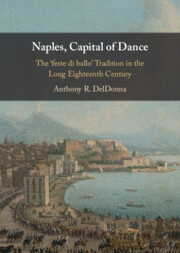Book contents
- Naples, Capital of Dance
- Naples, Capital of Dance
- Copyright page
- Dedication
- Contents
- Figures
- Tables
- Music Examples
- Acknowledgments
- Introduction
- 1 Celebratory Balls in the Kingdom of Naples
- 2 The Politics of Place and Spheres of Power
- 3 Seasons of Feste 1737 and 1747
- 4 The Dance Treatise in the Age of Reason
- 5 Seasons of Splendor
- 6 A Return to the Capital
- 7 Behind the Scenes, Between the Lines
- 8 The Neapolitan feste di ballo as (Historical) Soundscape
- Select Bibliography
- Index
6 - A Return to the Capital
Published online by Cambridge University Press: 10 April 2025
- Naples, Capital of Dance
- Naples, Capital of Dance
- Copyright page
- Dedication
- Contents
- Figures
- Tables
- Music Examples
- Acknowledgments
- Introduction
- 1 Celebratory Balls in the Kingdom of Naples
- 2 The Politics of Place and Spheres of Power
- 3 Seasons of Feste 1737 and 1747
- 4 The Dance Treatise in the Age of Reason
- 5 Seasons of Splendor
- 6 A Return to the Capital
- 7 Behind the Scenes, Between the Lines
- 8 The Neapolitan feste di ballo as (Historical) Soundscape
- Select Bibliography
- Index
Summary
The sixth chapter covers a broader expanse of time, yet provides equally detailed descriptions of the feste, as the tradition returned to the Teatro di San Carlo in 1774. Responding to criticisms of both Carlo di Borbone (now king of Spain) and the Neapolitan Secretary of State Bernardo Tanucci (who provided the Spanish sovereign with detailed complaints about the lifestyles of his son and consort), the feste di ballo returned to the capital city and the royal theater. In the period 1774–86, the feste take on greater significance, not only as an instrumentum regni projecting positive images of sovereignty, but also as a financial bulwark against the significant losses incurred in virtually every opera season (meticulously detailed in memoranda contained in the fondo Archivio Farnesiano). Surviving financial documents, personnel rosters, and ledgers provide important details about the annual feste, ranging from fundamental questions about the physical transformation of the theater into a dance space to the retention of key artistic and managerial personnel. These sources relate closely to and often confirm many of the observations found in the historical accounts of Sara Goudar and Magri’s treatise Trattato teorico-prattico di ballo (1779), among others.
Keywords
- Type
- Chapter
- Information
- Naples, Capital of DanceThe ‘feste di ballo' Tradition in the Long Eighteenth Century, pp. 125 - 156Publisher: Cambridge University PressPrint publication year: 2025

